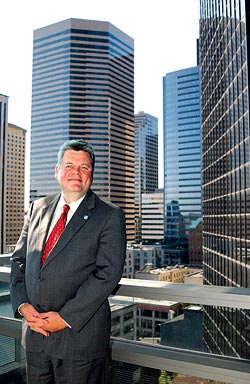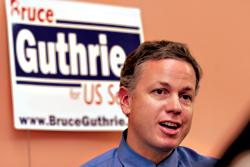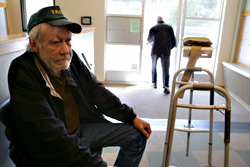Few things in life sound as unsexy as urban planning. The term is inextricably linked to public hearings, pushy developers, whiny good- government types, building codes, legalese, and vague buzzwords like “smart growth” and “livability.”
Frigid as urban planning sounds, Seattle politics and civic life are about to heat up because of it—and the question of how you do urban planning in such a way that it makes the downtown city core denser without chasing away the very people without whom increasing density makes little sense.
We’ve arrived at such a pass because of two forces. One is population growth and urban sprawl; the other is Mayor Greg Nickels.
Last May, Nickels introduced a proposal to rewrite the city’s planning code and dramatically raise building heights for office and residential buildings in downtown Seattle and in the Denny Triangle (an area north of downtown roughly bounded by Denny Way, Sixth Avenue, and I-5) in anticipation of as many as 44,000 more people and 50,000 more jobs flooding the center city—Lower Queen Anne to the International District—over the next 20 years.
Vancouver, B.C., and Portland, Ore., are the exemplars that Nickels and many others in urban planning point to as evidence that big cities can absorb many thousands of new residents in their urban core. Both Northwest cities largely pulled off the trick of getting more people living and working downtown and limiting suburban sprawl, while making the whole thing look damn good in the process. Both cities worked overtime to create residential housing that made the new construction an integral and revitalizing part of downtown neighborhoods.
As it exists now, Nickels envisions proposed code changes that would do little to instill a neighborhood feel in the city center. His plan would lift Seattle’s two-decades-old building height cap of 450 feet (about 45 stories) to accommodate 700-foot-high office buildings downtown (about the height of the WaMu Tower) and 400-foot-high residential towers in downtown and the Denny Triangle (about 40 stories). It’s a move that would reshape Seattle’s skyline, alter views from surrounding hills, and change the city’s streetscape for the next 100 years.
“We’ve got to do it gracefully,” Nickels says. Many Seattleites wouldn’t use “grace” to describe the mayor’s political style. His is the buccaneering, mailed-fist style of governance versus the old Seattle style of consensus and death by process.
The trouble is that the mayor’s original plan did little to address the very things that have made Portland and Vancouver so livable and walkable, such as parks and trees. It was mute on how buildings should look, especially at street level where presumably future generations of Seattleites will spend most of their waking hours. And it was silent on whether these would be urban enclaves for the rich and the single or if people of more modest incomes could afford to live there as well, especially families.
“If you want to impact sprawl, you have to impact families,” says City Council member Peter Steinbrueck. “That’s why there’s sprawl in the first place. They can’t find housing in the city that meets their income level.” An architect by training, Steinbrueck was the prime mover behind the 1980s-era building cap. He’s literally a child of the old Seattle, a champion of process and son of Victor Steinbrueck, the architect and activist often credited with saving Pike Place Market from developers in the 1970s.
Where Nickels pushes to change both Seattle and the Seattle way of doing things, Steinbrueck stands as a kind of gatekeeper to the city’s hard-won livability, a voice for balancing Seattle’s world-city ambitions with its traditional values.
The City Council will ultimately hold the keys to the mayor’s city vision. It will determine how future development is translated into the dry language of the municipal code. For the mayor to realize his ideas, he will have to go through Steinbrueck, who chairs the council’s Urban Development & Planning Committee.
Steinbrueck isn’t exactly in love with the mayor’s plan. No sooner had the details hit his desk last spring than he hired two consultants to look it over. These weren’t any old consultants, either. They were Ray Spaxman and Larry Beasley, the planners credited with making modern Vancouver, a city of glass and urban neighborhoods, as vibrant as Manhattan or San Francisco. Where Nickels wants to rush ahead and get his plan adopted by year-end, Steinbrueck wants to exercise patience and diligence. After all, if we’re reshaping the city for the next century, what’s the hurry?
His approach already seems to have had an effect.
On Monday, Aug. 8, Steinbrueck’s two consultants delivered a report to the City Council that in careful, diplomatic terms poked holes in the Nickels plan, particularly as it relates to attracting families to downtown.
“Make sure you are absolutely clear about what kind of place you want,” Beasley said. “Otherwise, the consumer won’t come, and it won’t work.”
Nickels must have been grinning to himself in his seventh floor City Hall office. He had quietly pre-empted some of the report’s anticipated objections the week before. On Aug. 2, Nickels’ office released a proposal to generate funding for center city parks and green space, two of the prime ingredients for creating successful neighborhoods. That move only began to address the consultants’ criticisms—and went almost nowhere toward addressing Steinbrueck’s concerns about who will actually live in the core.
It was the opening battle cry over whether downtown and the Denny Triangle will be real neighborhoods that people will actually want to live in or neighborhoods in name only.
Putting an End to Issaquah

Vancouver created suburbs in the sky with skinny towers.
(Philip Dawdy) |
No doubt about it, the bodies are coming. There’s nothing process can do to alter that. Many local urban planners, regional thinkers, and demographers say that Seattle will see 100,000 new residents by 2024. They’ve got to go somewhere.
If America were doing development the way it did in the 1970s, all those bodies would migrate north and south and east of the city, moving into a world of single-family tract houses, an Issaquah with no end.
But times have changed. There is an end to Issaquah. In 1990, the state’s Growth Management Act went into law, designed to limit sprawl and channel growth into the region’s urban areas. No one here was interested in repeating the experience of California. In the San Francisco Bay Area, workers sometimes commute two and a half hours in each direction from the Sierra foothills to San Francisco in hellish traffic. Bay Area hillsides, where children rode horses 30 years ago, are covered with tightly packed homes, and every species aside from Homo sapiens is on the run.
Growth like that isn’t sustainable, so governments in Washington and Oregon, for example, devised a scheme to herd some of that sprawl into urban centers. Officials in the Vancouver, B.C., metro area did the same thing.
These moves came just as a new generational epoch was sweeping North America. The baby boomers and Generation Xers were staying single longer than ever in American history. They were having children well into their 30s instead of in their early 20s—if they had children at all. For them, the suburbs made, and make, no sense—at least until they have kids.
As a result, cities like Seattle, San Francisco, and Portland have become havens for singles and the loosely attached. Seattle has the second-highest concentration of childless households in America (San Francisco is first). It is also one of the cities with the most singles.
The city of Seattle wants to have the next wave of single immigrants live right smack downtown and in the Denny Triangle. “That’s where the open palette is,” says John Rahaim, city planning director, referring to the Denny Triangle, where there are many parking lots and no-rise commercial buildings—property begging to be developed mere blocks from the downtown office and retail core.
That things are headed this way should comfort anyone who’s watched development shape up in the Western United States over the last generation. In states like Arizona, California, and Utah, there was very little urban planning and very much sprawl. In Salt Lake City, gas stations sit next to grand Victorian houses. In the Phoenix metro area, so many people are moving in that 200 new homes—mostly single-family ones—go on the market each day. A similar lack of foresight and unplanned growth would destroy everything that makes the Seattle metro area so livable.
In anticipation of the day when push would come to shove, the city and local neighborhood committees have over the last five years etched out a plan to take most of these bodies into a swath of neighborhoods from Lower Queen Anne to the International District. Most of the residential development would occur in the north end of downtown and in the Denny Triangle, according to the city’s Department of Planning & Development. The office towers would largely be folded in amongst current office buildings between Pike Street and Pioneer Square.
And thus was born the Nickels “Center City Strategy” and all the talk of replicating Portland and Vancouver here in Rain City.
Eyes on the Street
When urban planners and policy wonks talk about smart growth and livability, Portland and Vancouver are held up like religious icons.
Portland is known for its downtown of brick sidewalks and its parks along the Willamette River, of course, products of the 1970s and 1980s. But these days when planning geeks gush about Portland, their ardor is directed at the Pearl District. It’s an area of orderly and flashy condominium complexes and shops and restaurants due north of downtown Portland. It has all the gloss of Palm Beach, Fla., or La Jolla, Calif. Only a decade ago, it was an area of empty industrial lots and no-rise commercial development.
Now, it is walkable and livable. There are outstanding restaurants, like Bluehour, at each corner, it seems. There are grand walkways and parks. There are even special fountains for dogs designed by artist William Wegman. The buildings are not particularly tall. Most are fewer than 10 stories.
But the Pearl District has a problem.
Living there is not cheap. A 450-square-foot studio, if you can find one on the market, is valued at $225,000. Two bedrooms can easily run you well over $500,000.
There are few families in the Pearl District as a result. The Pearl, as its residents love to call it, is neck and neck with San Francisco’s Castro District as the most dense single neighborhood in America. In effect, it’s the largest yuppie ghetto in the country.
Ironically, the Pearl is home to only about 2,000 people, according to the Portland Business Alliance, a rather small community for all the attention that’s been lavished upon it in the urban planning hagiography.
Current projections by the city of Seattle call for about 6,000 new residents downtown and in the Denny Triangle in the near future. It won’t be the last wave of new residents to the area, either.
Vancouver, on the other hand, has had to absorb 40,000 people into its urban center city limits since 1995—essentially the same number of new residents that Seattle aims to bring into its urban core over the next 20 years. Vancouver did it in half the time.
City planners there turned to the slim glass towers that had sprouted up in Asia—mostly in Hong Kong and Singapore—to house that wave of immigration. Vancouver created suburbs in the sky.
But when you walk the streets of Coal Harbour and Yaletown, west and south of downtown, it doesn’t feel like that many people could possibly live there. The buildings are not oppressive, although many of them hit 30 stories in height. They feel weirdly human-scaled instead of having that Trump Tower feel that so many 30- and 40-story residential buildings have in Manhattan. It’s like a series of sleek neighborhoods broke out in Vancouver overnight.
The way that happened, according to Vancouver officials, is that the city paid attention to what was happening on the ground. Ray Spaxman and Larry Beasley—Steinbrueck’s consultants—get much of the credit. Spaxman was planning director of Vancouver from 1973 to 1989. Beasley, Spaxman’s former deputy, became planning director in 1992.
When I spoke with them recently at a Denman Street coffee shop, they explained that they hadn’t only looked to Asia as a design model.
“We looked at London and Boston and New York,” says Beasley.
He and Spaxman then told me what they saw in those cities—where most of the dense urban development was finished almost 100 years ago—was that there was life on the streets in neighborhoods that felt like real neighborhoods. That life wasn’t a result of the ground-floor retail with upper stories of housing that is all the rage in urban development in this country right now, especially in Portland. Much of Nickels’ plan rests on the assumption that new construction will be of the ground-floor-retail variety.
Instead, it was because there were ground-floor residences throughout these cities—the old row houses or brownstones that are so prominent around parts of London, such as Russell Square, and in East Coast cities. Places, in other words, that are neighborhoods in the classic sense of the term. What’s more, there were children and families and dogs in these neighborhoods.
And those were the precepts they brought to Vancouver to make its dense neighborhoods feel like neighborhoods, as opposed to resembling a scene out of the dystopian future of Metropolis.
“Eyes on the street” is how they explained the organizing principle. Twenty-five percent of the new residential construction has to be set aside for families. “We paid attention to families and dogs,” says Beasley. In Vancouver’s urban core, there are now 3,000 children with 60 babies being born each month.
Maples and Row Houses

Vancouver puts “eyes” on the street with row houses.
(Philip Dawdy) |
I was tempted to blow off Beasley and Spaxman’s enthusiasm as mere civic pride. But after walking 100 blocks through Vancouver’s city of glass, I realized my initial skepticism was clearly misplaced.
Each time I turned a corner in Yaletown—due south of the downtown commercial core—I was awestruck by how completely the neighborhood qualities Vancouver planners aimed for were present in a dynamic human environment. People walked everywhere. Or biked. Dogs chased balls in small parks right across Beach Street from an apartment tower (the word “condo” isn’t used north of the border). Mothers pushed babies in strollers.
Many of the city’s vaunted glass towers weren’t built flush to the sidewalk, as is often the case in Seattle. Instead, planners required a setback of about 25 feet, at least for some projects, as well as ground-floor residences. In the States, such setbacks and open spaces commonly lead to tiny sterile plazas with bad sculpture or to a commercial zone of ground-floor retail and cafe tables. If you aren’t buying, then you don’t get to sit there.
In Vancouver, the space was largely eaten up by swaths of Japanese maples and shrubs, which in turn screened the front doors of town houses, or row houses in the Vancouver term. Where there aren’t row houses, the forested buffers house benches and fountains. Anyone walking by can sit there.
Compared to how residential and commercial development is done in this country, Vancouver is a revelation. It feels right in a way that all the development in Belltown never has. It comes off as no more oppressive than densely populated parts of Capitol Hill even though the buildings are 30 stories.
And these buildings don’t crowd out the sky. Vancouver’s many spectacular views were preserved, principally because developers weren’t allowed to build blockwide structures that simply shot upward several hundred feet. Instead, Vancouver planners created a system where developers could only build a tower with a base far narrower than the buildable property line. In many cases, the towers sprout from blockwide structures about five stories high featuring row houses or grand apartments. Coupled with the city’s required setbacks and greenery, the towers seem benign.
These are expensive buildings to buy into, of course. Two bedrooms can run $400,000 or more. Some row houses of 2,700 square feet list for about $1.2 million. But there are also studios that go for around $170,000, somewhat more in reach of the average urban dweller.
Families have moved into this mix in Vancouver. The city has already opened one new elementary school downtown, and another one is slated to open in 2006, according to Beasley.
Vancouver’s development did have one heavy consequence, however. Much of the city’s druggie and vagrant populations has been pushed east of downtown into what’s little more than a free-fire zone of heroin junkies, meth heads, and street criminals. One Vancouver cop I met calls it “total anarchy.”
Spaxman and Beasley admit that it was their largest failing as urban planners.
Getting Families Back

Portland’s Pearl District: lovely to look at, but where are the families?
(Tim Kuhlman) |
The Vancouver planning duo see many opportunities for unintended failings in Nickels’ plan, especially when it comes to residential zoning in the Denny Triangle. In that area, called the DMC zone, commercial buildings will be permitted to rise 240 feet, while residential towers can go 400 feet high.
Their chief criticism is that the plan will not create real neighborhoods, and in turn, that will encourage families to go east to Issaquah.
“Family households often believe they have no choice but to move to the suburbs,” Spaxman and Beasley wrote in their report. “They will only be attracted to communities that have food, schools, parks, child care facilities, services and community centers. These are the very households that make up most of the demand for urban sprawl.”
If Nickels’ plan were enacted in its present form, the two consultants project that towers won’t be narrow enough to be unobtrusive. Also, their analysis states that without proper setbacks from sidewalks and without enough space between towers, buildings “will still produce considerable overlook and shadowing on adjoining streets.”
What’s more, the Nickels plan doesn’t have incentives or funding to create the very neighborhood amenities such as schools, shopping areas, and small green spaces that have attracted new residents to Vancouver and, to a lesser degree, Portland. They suggest that Nickels’ plan would produce density—just not the density anyone with kids would want to live in.
They suggest, too, that the city create models (computer and physical) of areas slated for redevelopment in order to get a grasp on how new buildings will affect one another. Beasley says that approach was essential in making Vancouver’s buildings fit together as well as they do.
Their criticisms were seized upon by City Council members on Monday, Aug. 8.
“We don’t often have this opportunity to shape major parts of the city, and we’ve got to do it right,” said council member Tom Rasmussen.
Council member David Della expressed concern about how rezoning in the urban core would incorporate working families. Council member Jan Drago pledged to work with Steinbrueck.
Nickels’ office professed delight with the report.
“We think the consultants’ report endorsed our vision of what to do with downtown,” says Marty McOmber, a Nickels spokesperson.
A Fuller Vision

Says Steinbrueck: “If you want to impact sprawl, you have to impact families.”
(Laura Schmitt) |
As city politics turn, it will be left to Steinbrueck to turn the plan into something that embodies not just the tall towers of Vancouver, but all the street-level amenities that actually made that city’s development into more than a collection of high-rise housing projects.
Two weeks ago, a string of Seattle developers took the microphone at his committee meeting to encourage him to adopt the mayor’s plan and uncork building heights downtown and in the Denny Triangle. Among them was William Justen, managing director of the Samis Foundation, which holds several major properties in the affected areas. He said that Seattle’s goal should not be to be like Vancouver.
Steinbrueck was listening but not buying. He says that soon after Nickels’ plan was announced in May—and before the City Council received the plan’s precise planning code language in June—his office was swamped with letters from developers urging that the council approve the Nickels plan posthaste.
Steinbrueck looks at downtown and the Denny Triangle differently than developers. He sees downtown as a missed opportunity over the last generation—filled with office towers and tens of thousands of workers, but a place where few live, despite the fact that there have been few restrictions on building residences.
“There’s just one thing we need now—it’s a downtown where families can live and people can find things where they live,” he says. “Whatever we do, we can’t do that just by raising building heights.”
Spaxman and Beasley’s report notes that although there are now very few restrictions on building residential units downtown and in the Denny Triangle, few new residential units have been built there in recent years. (Vulcan’s 2200 Westlake building in the north end of the Denny Triangle is an exception.) So why would increasing building heights by hundreds of feet change that?
Steinbrueck says the way to do that is by encouraging livability and constructing an appealing downtown and Denny Triangle that will create a market for urban living that will be a magnet for families, not just singles and well-to-do empty-nester couples dashing between high-paying office jobs and the symphony or theater. In other words, not another Pearl District but another Vancouver.
“Seattle has lost its families,” he says. “If we want to curb sprawl, we’ve got to get more families and create neighborhoods they want to live in.”
That perspective clashes directly with the Nickels plan, which is little more than a plan to raise the two-decades-old building cap and add none of the social amenities that attract a diverse mix of residents.
“I think I have a better and fuller vision” than the mayor, says Steinbrueck.
Developers Hungry, Mayor in a Hurry

Says Nickels: “Families are going to be a challenge.”
(Laura Schmitt) |
Certainly, Nickels has sensed looming criticisms since his plan was released in May. Critics said the plan offered little in the way of open and green space. Last week, the mayor attempted to pre-empt those objections and the impending report from Steinbrueck’s Vancouver planners.
Two hours before a reporter was scheduled to meet with the mayor and ask about, among other things, his plan’s lack of green spaces, the mayor’s office released a proposal to charge developers a fee for each new square foot they construct to fund about 12 acres of new parks. Most would be in the Denny Triangle. The impact fee, as it’s called, would raise a projected $57 million and cost developers $1 to $2 per square foot.
“We’ve been listening,” says Nickels.
Nickels said the release had been long planned. Steinbrueck says that no one on the council had heard of the proposal or knew it was coming.
In an interview, the mayor said he liked how development had shaped up in Vancouver, especially that city’s emphasis on what the mayor calls “smart growth.” “It’s a great model for us,” he says. Asked about the two precepts—an emphasis on families and dogs—that Vancouver planners say turned their city into a livable urban oasis, Nickels paused.
“Families are going to be a challenge,” he said, then pointed out that he wants Seattle’s downtown to be family-friendly with safe and attractive public parks.
Did he have an idea about where the working class—singles or families—might live in this array of shiny new glass towers?
The mayor pointed due west of his City Hall office to the city-owned Alaska and Loman buildings. The Alaska Building currently houses some city offices. He explained that the city planned to sell the properties for “workforce housing.” Together, the two buildings along First and Second avenues would house a few hundred people, tops.
Nickels had no answer for how families and average workers (earning about $40,000, according to city estimates) would find affordable housing downtown or in the Denny Triangle.
Developer Justen says the smallest unit in his proposed 37-story tower at Second Avenue and Pike Street would be two bedrooms and 1,645 square feet. He declined to discuss prices, but similarly sized units in Portland, for example, easily top $500,000 and rapidly increase from there, according to recent listings in that city.
Justen says that developing new residences angled toward so-called workforce housing is tough. “I can’t get a loan to build that kind of building,” he says.
Justen would like to break ground next spring. Other developers are just as hungry. According to the city’s Department of Planning & Development, there are over a dozen pending residential projects slated for downtown and the Denny Triangle in various stages of permitting and planning.
The mayor is in a hurry as well. “We ought to be able to have it [the code change] done by the end of year,” Nickels says. He doesn’t fancy Steinbrueck’s plan to take until late next spring to hammer out the details.
What’s the rush? Nickels says he wants the City Council to spend next year focusing on neighborhood commercial districts.
The mayor, however, doesn’t run the City Council or Steinbrueck.
“There’s no way—it won’t be this year,” says Steinbrueck, who denies that any of this is shaping up as a personal dispute between himself and Nickels. Steinbrueck points out that much of the council’s work this fall will of necessity revolve around budget work for 2006.
“I won’t be intimidated or pressured into prematurely approving legislation that is inadequate in order to meet an artificial time constraint,” he says.
In an interview last week, Steinbrueck announced that he will hire a development consultant to do a financial analysis of what the mayor’s plan means in terms of sheer profit for downtown and Denny Triangle developers. He didn’t say where that analysis might lead, but has previously stated that the simple act of raising building heights—by hundreds of feet in some cases—would boost the value of undeveloped properties dramatically. Steinbrueck wants to quantify what’s in the mayor’s plan for developers, sensing that it may hold a clue as to why they and the mayor are so interested in rushing the plan through the council.
McOmber says the mayor has no trouble with Steinbrueck undertaking such a study—as long as it doesn’t derail Nickels’ year-end-or-bust goal.
Some council members, however, are willing to defer to Steinbrueck’s pace.
“Whatever Peter wants, I am with him,” says council member Nick Licata. “He understands the complexities and subtleties of planning.”
Others, like Rasmussen, want to ensure that the process is careful and thorough, especially when it comes to determining how to create open space, schools, and community centers along with the housing—amenities as they are known in planner-speak. Such amenities are usually funded through incentives for developers or impact fees.
“When heights increase, you are making gold for owners of the property,” said Rasmussen. “The question is: How much of that gold will be shared with the public?”








